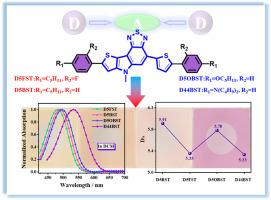Thiophene-pyrrole fused benzothiadiazole guest-host dyes for electrically switchable liquid crystal windows
IF 4.2
3区 工程技术
Q2 CHEMISTRY, APPLIED
引用次数: 0
Abstract
Dichroic dye-doped liquid crystal (DLC) dimmable glass has the potential in a wide range of applications in the field of smart windows, however, its poor photostability and limited dimming range constrain its large-scale application. In this study, through the incorporation of thiophene-pyrrole fused benzothiadiazole acceptor units, we successfully designed and synthesized four novel dichroic dyes (D5FST, D5BST, D5OBST, and D44BST). Solution-phase studies revealed that all four dyes exhibited tunable photophysical properties. However, D5OBST demonstrated limited solubility in the host LC mixture Host-2301 and was consequently excluded from device-level evaluations. The remaining three dyes displayed excellent compatibility with the host LC, enabling electrically controlled transparency switching. Notably, D44BST achieved the largest absorption/emission wavelengths (534/670 nm), while D5BST exhibited the highest dichroic ratio (DA = 5.91). These findings provide critical insights for developing high-performance dichroic dyes, while highlighting the importance of host-guest compatibility in material design.

噻吩-吡咯熔融苯并噻唑主-主染料电开关液晶窗口
二向色染料掺杂液晶(DLC)可调光玻璃在智能窗领域具有广泛的应用潜力,但其光稳定性差和调光范围有限限制了其大规模应用。本研究通过引入噻吩-吡咯融合苯并噻唑受体单元,成功设计合成了四种新型二色性染料(D5FST、D5BST、D5OBST和D44BST)。溶液阶段的研究表明,这四种染料都表现出可调的光物理性质。然而,D5OBST在宿主LC混合物host -2301中的溶解度有限,因此被排除在设备级评估之外。其余三种染料与宿主LC表现出良好的兼容性,实现了电控透明开关。值得注意的是,D44BST的吸收/发射波长最大(534/670 nm),而D5BST的二向色比最高(DA = 5.91)。这些发现为开发高性能二色性染料提供了重要见解,同时强调了材料设计中主客体兼容性的重要性。
本文章由计算机程序翻译,如有差异,请以英文原文为准。
求助全文
约1分钟内获得全文
求助全文
来源期刊

Dyes and Pigments
工程技术-材料科学:纺织
CiteScore
8.20
自引率
13.30%
发文量
933
审稿时长
33 days
期刊介绍:
Dyes and Pigments covers the scientific and technical aspects of the chemistry and physics of dyes, pigments and their intermediates. Emphasis is placed on the properties of the colouring matters themselves rather than on their applications or the system in which they may be applied.
Thus the journal accepts research and review papers on the synthesis of dyes, pigments and intermediates, their physical or chemical properties, e.g. spectroscopic, surface, solution or solid state characteristics, the physical aspects of their preparation, e.g. precipitation, nucleation and growth, crystal formation, liquid crystalline characteristics, their photochemical, ecological or biological properties and the relationship between colour and chemical constitution. However, papers are considered which deal with the more fundamental aspects of colourant application and of the interactions of colourants with substrates or media.
The journal will interest a wide variety of workers in a range of disciplines whose work involves dyes, pigments and their intermediates, and provides a platform for investigators with common interests but diverse fields of activity such as cosmetics, reprographics, dye and pigment synthesis, medical research, polymers, etc.
 求助内容:
求助内容: 应助结果提醒方式:
应助结果提醒方式:


